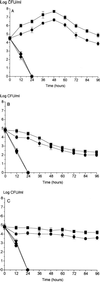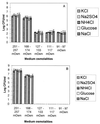Effect of low-osmolality nutrient media on growth and culturability of Campylobacter species
- PMID: 9835543
- PMCID: PMC90903
- DOI: 10.1128/AEM.64.12.4643-4649.1998
Effect of low-osmolality nutrient media on growth and culturability of Campylobacter species
Abstract
The growth and culturability of Campylobacter jejuni NCTC 11351 and other campylobacters were examined in media having different osmolalities at a range of temperatures (4, 25, and 42 degreesC). The medium osmolalities used ranged from the osmolality of full-strength nutrient medium (modified campylobacter broth having an osmolality of around 254 mosmol) down to 96 mosmol. The following two methods were used to produce media having different osmolalities: dilution of the nutrient medium with distilled water and reformulation of the medium such that the concentrations of various osmolytes were altered while the nutrient content of the medium was unchanged. The results obtained with the two experimental methods were similar, indicating that there was an osmotic threshold effect, such that none of the campylobacters examined (C. jejuni NCTC 11351 and ATCC 33291, Campylobacter lari, and Campylobacter coli) grew in media having osmolalities around 130 mosmol and at temperatures below at 42 degreesC. Conversely, growth occurred in media having osmolalities of around 175 mosmol and above. Osmolar concentrations can be expressed in terms of osmolarity or osmolality. Osmolality is easier to evaluate, is the more commonly used term, and was used in the current study. In nutrient media having low osmolalities (i.e., 130 mosmol and below), the number of CFUs per milliliter declined rapidly regardless of the temperature, and no cells were recovered after 24 h. However, at nongrowth temperatures (25 and 4 degreesC) in higher-osmolality media (175 mosmol and above) a significant population was recovered throughout the experiment (up to 96 h). In low-osmolality nutrient media, the cellular morphology was principally coccoid, while in the early stages of growth in full-strength media the morphology was predominantly rodlike. We propose that the formation of coccoid cells in these experiments was the result of osmotic stress in low-osmolality media. This osmotic effect was apparent regardless of the osmolyte used to reformulate the medium (NaCl, KCl, Na2SO4, NH4Cl, and glucose were used).
Figures





Similar articles
-
The effects of UVB and temperature on the survival of natural populations and pure cultures of Campylobacter jejuni, Camp. coli, Camp. lari and urease-positive thermophilic campylobacters (UPTC) in surface waters.J Appl Microbiol. 2001 Feb;90(2):256-67. doi: 10.1046/j.1365-2672.2001.01239.x. J Appl Microbiol. 2001. PMID: 11168729
-
Better preservation of Campylobacter jejuni/C. coli in a defined medium.Indian J Med Res. 1991 Jan;93:26-8. Indian J Med Res. 1991. PMID: 2022397
-
Utilization of osmoprotective compounds by hybridoma cells exposed to hyperosmotic stress.Biotechnol Bioeng. 1994 Jan 5;43(1):77-89. doi: 10.1002/bit.260430111. Biotechnol Bioeng. 1994. PMID: 18613313
-
Media composition: salts and osmolality.Methods Mol Biol. 2012;912:61-80. doi: 10.1007/978-1-61779-971-6_5. Methods Mol Biol. 2012. PMID: 22829369 Review.
-
Culture media for the isolation of campylobacters.Int J Food Microbiol. 1995 Jun;26(1):43-76. doi: 10.1016/0168-1605(95)00044-k. Int J Food Microbiol. 1995. PMID: 7662519 Review.
Cited by
-
Comparison of survival of Campylobacter jejuni in the phyllosphere with that in the rhizosphere of spinach and radish plants.Appl Environ Microbiol. 2004 Feb;70(2):1182-9. doi: 10.1128/AEM.70.2.1182-1189.2004. Appl Environ Microbiol. 2004. PMID: 14766604 Free PMC article.
-
Defining established and emerging microbial risks in the aquatic environment: current knowledge, implications, and outlooks.Int J Microbiol. 2011;2011:462832. doi: 10.1155/2011/462832. Epub 2010 Sep 27. Int J Microbiol. 2011. PMID: 20976256 Free PMC article.
-
Effect of environmental stress factors on the uptake and survival of Campylobacter jejuni in Acanthamoeba castellanii.BMC Microbiol. 2012 Oct 11;12:232. doi: 10.1186/1471-2180-12-232. BMC Microbiol. 2012. PMID: 23051891 Free PMC article.
-
Characterization of Campylobacter jejuni biofilms under defined growth conditions.Appl Environ Microbiol. 2007 Mar;73(6):1908-13. doi: 10.1128/AEM.00740-06. Epub 2007 Jan 26. Appl Environ Microbiol. 2007. PMID: 17259368 Free PMC article.
-
Antimicrobial and Virulence-Modulating Effects of Clove Essential Oil on the Foodborne Pathogen Campylobacter jejuni.Appl Environ Microbiol. 2016 Sep 30;82(20):6158-6166. doi: 10.1128/AEM.01221-16. Print 2016 Oct 15. Appl Environ Microbiol. 2016. PMID: 27520816 Free PMC article.
References
-
- Abram D D, Potter N N. Survival of Campylobacter jejuni at different temperatures in broth, beef, chicken and cod supplemented with sodium chloride. J Food Prot. 1984;47:795–800. - PubMed
-
- Advisory Committee on the Microbiological Safety of Foods. Interim report on Campylobacter. London, United Kingdom: Her Majesty’s Stationery Office; 1993.
-
- Baggerman W I, Koster T. A comparison of enrichment and membrane filtration methods for isolation of Campylobacter from fresh and frozen foods. Food Microbiol. 1992;9:87–94.
-
- Baker D A, Park R W. Changes in morphology and cell wall structure that occur during growth of Vibrio sp. NCTC 4716 in batch culture. J Gen Microbiol. 1975;86:12–28. - PubMed
-
- Beumer R R, De Vries J, Rombous F M. Campylobacter jejuni nonculturable coccoid cells. Int J Food Microbiol. 1992;15:153–163. - PubMed
Publication types
MeSH terms
Substances
LinkOut - more resources
Full Text Sources
Other Literature Sources
Molecular Biology Databases

